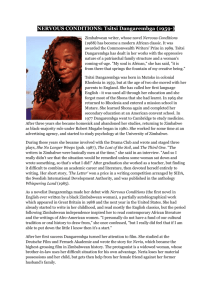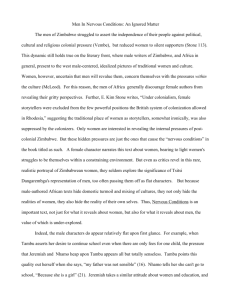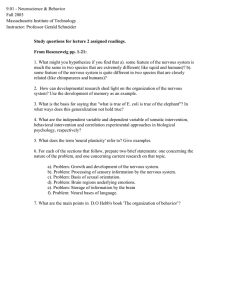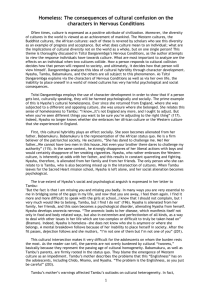Nervous Conditions
advertisement
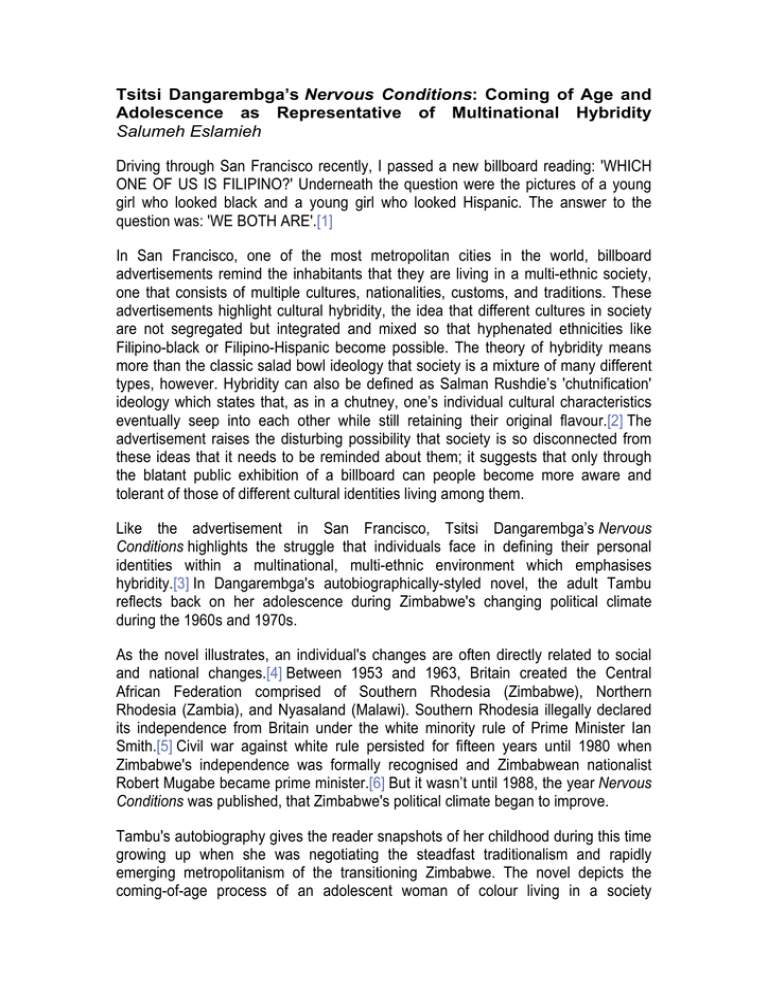
Tsitsi Dangarembga’s Nervous Conditions: Coming of Age and Adolescence as Representative of Multinational Hybridity Salumeh Eslamieh Driving through San Francisco recently, I passed a new billboard reading: 'WHICH ONE OF US IS FILIPINO?' Underneath the question were the pictures of a young girl who looked black and a young girl who looked Hispanic. The answer to the question was: 'WE BOTH ARE'.[1] In San Francisco, one of the most metropolitan cities in the world, billboard advertisements remind the inhabitants that they are living in a multi-ethnic society, one that consists of multiple cultures, nationalities, customs, and traditions. These advertisements highlight cultural hybridity, the idea that different cultures in society are not segregated but integrated and mixed so that hyphenated ethnicities like Filipino-black or Filipino-Hispanic become possible. The theory of hybridity means more than the classic salad bowl ideology that society is a mixture of many different types, however. Hybridity can also be defined as Salman Rushdie’s 'chutnification' ideology which states that, as in a chutney, one’s individual cultural characteristics eventually seep into each other while still retaining their original flavour.[2] The advertisement raises the disturbing possibility that society is so disconnected from these ideas that it needs to be reminded about them; it suggests that only through the blatant public exhibition of a billboard can people become more aware and tolerant of those of different cultural identities living among them. Like the advertisement in San Francisco, Tsitsi Dangarembga’s Nervous Conditions highlights the struggle that individuals face in defining their personal identities within a multinational, multi-ethnic environment which emphasises hybridity.[3] In Dangarembga's autobiographically-styled novel, the adult Tambu reflects back on her adolescence during Zimbabwe's changing political climate during the 1960s and 1970s. As the novel illustrates, an individual's changes are often directly related to social and national changes.[4] Between 1953 and 1963, Britain created the Central African Federation comprised of Southern Rhodesia (Zimbabwe), Northern Rhodesia (Zambia), and Nyasaland (Malawi). Southern Rhodesia illegally declared its independence from Britain under the white minority rule of Prime Minister Ian Smith.[5] Civil war against white rule persisted for fifteen years until 1980 when Zimbabwe's independence was formally recognised and Zimbabwean nationalist Robert Mugabe became prime minister.[6] But it wasn’t until 1988, the year Nervous Conditions was published, that Zimbabwe's political climate began to improve. Tambu's autobiography gives the reader snapshots of her childhood during this time growing up when she was negotiating the steadfast traditionalism and rapidly emerging metropolitanism of the transitioning Zimbabwe. The novel depicts the coming-of-age process of an adolescent woman of colour living in a society transforming into a multinational Westernized one. Adolescence and coming of age might be thought of as representative of multinational hybridity. Theoretically, if the self is perpetually in a metaphoric adolescent stage of hybridity, possessing the multiple identities of the past and the future, then the self is perpetually 'coming of age'. This process is elliptical in that one is able to adapt as new changes occur, and also avoids an outdated frame of mind and any feelings of alienation from the new culture. Cultural developments in Zimbabwe resulted largely from the economic and political changes of the nation. Zimbabwe experienced multiple identity shifts, including changes in borders, rulers, and even the name of the nation, thus affecting the national identity of the people. Dangarembga's ideas mirror both the socio-political influence of the civil war against Ian Smith's rule for which the second generation of English-educated Zimbabweans is known and the themes of alienation from both family life and European culture for which the third generation is known.[7] Since the issues of war and politics were a part of everyday conversation, urbanization led to more opportunities and there was an influx of independent ideas. Additionally, this generation of Zimbabwean authors who wanted to communicate their ideas to the international public had the advantage of an English education. However, as is common to transitioning governments and societies, censorship laws were enforced, so, ironically, authors writing about their own country and culture had to try to get published abroad, and thus wrote in English.[8] Nervous Conditions and Dangarembga were not exempt from this national phenomenon of censorship: Nervous Conditions [became] the first published novel in English by a black Zimbabwean woman [...] First submitted to a Zimbabwean publisher, [it] was rejected. The pointedly feminist perspective was apparently off-putting to the editor concerned.[9] By publishing abroad, Zimbabwean authors like Dangarembga have contributed to the drive towards an international language for communication, a means of expression in a multinational, global community which is proving vital as nations are constantly subjected to international political turmoil. Her character Tambu is able to provide the reader with an account and analysis of growing up in a society in transition. She shifts between a recollection of past events to an analysis of those events in order to reveal that the past is just as much a part of one’s existence as is the ability to evolve with the present and the future. Tambu tells of more than her own past; she is also telling a history of her people and her nation, thus showing the enduring struggles that have formed the identities of her people and what it means to be ‘African’. Moreover, she does it in a written form which succeeds the oral history form which was passed down to her. Thus Tambu simultaneously argues for the value of her Western education by writing an English text. Chinua Achebe describes Africans who write their stories in English as: A new voice coming out of Africa, speaking of African experience in a world-wide language [...] The African writer should aim to use English in a way that brings out his message best without altering the language to the extent that its value as a medium of international exchange will be lost. He should aim at fashioning out an English which is at once universal and able to carry his peculiar experience.[10] The individual growing up in a multinational hybrid society struggles to keep the tradition of his or her past while modernisation rapidly takes over. Using English words may seem like an insufficient way to express her life as a Zimbabwean but it is the only way Tambu can truly articulate her hybridity and the hybridity of people in contemporary society. Throughout the novel, Tambu’s mother preaches against 'the Englishness', stating that 'the Englishness will kill you'.[11] But Tambu survives the inevitable 'Englishness' because she has kept her tradition alive within herself. A non-Western individual cannot adapt him or herself to Western society without the past re-emerging. Writing retrospectively about her past, and moreover writing about herself, her people, and their traditions in the language of international exchange, English, Tambu makes it evident that the intermingling of the tradition of the past and the modernisation of the future will always have a symbiotic relationship in society. A central part of African identity consists of this symbiotic relationship between tradition and modernism, which results from living in a multinational society. Dangarembga commands older Tambu to take the reader through a journey of her past in order to use the adolescent state as a metaphor for the individual experiencing these changes. Since the state of change between child and adult is termed adolescence, adolescence can be used as a metaphor for change, multiplicity, and contradictions unified through one identity that exists as a hybrid. The combination of the past and the uncertain future are evident within the psyche of the self as the adolescent is caught between a child's identity and an adult's identity. One informs the other, thus 'othering' the adolescent from him or herself. Paired with the sense of cultural Otherness, the adolescent stage is by nature a stage of otherness whereby one, through change, becomes conscious of the past as history and the future as a tangible thing to come; thus, it is where one begins to exist in the history of the past. Remembering the struggles of the past is therefore helpful in having faith in changes in the future. The cultural mirror held up to black girls produces a profound sense of Otherness [...] black women fiction writers vividly describe girls' discovery of this Otherness; it is central to their heroines' coming of age.[12] In a multinational society, where the West defines non-Westerners as the Other, one’s discovery of Otherness can be damaging. The problem lies in the reason individuals are 'othered' in society: society's inability to cope with the fact of people looking different from one another, yet acting the same. In today's society, where cultures and customs are becoming increasingly intertwined, this inability is becoming more common. Cultural hybridity causes the individual to be pulled in multiple directions, adopting identities which may differ from one another. Thus individuals begin to identify with discourses which may be foreign to his or her own. As an adolescent, Tambu is being pulled in multiple directions — biologically, physically, and emotionally — and embodies the nervous condition of the Other that Jean-Paul Sartre mentions in the preface to Frantz Fanon’s The Wretched of the Earth. Sartre writes, 'The status of "native" is a nervous condition introduced and maintained by the settler among colonized people with their consent'.[13] Dangarembga is in fact responding to two ideas presented by Sartre: the idea of the nervous condition and the idea of 'consenting' to possessing it. The 'nervous condition' is understood as explaining the position of the native who feels as though she or he occupies multiple identities, some of which contradict other identities. The colonizer who imposes ideas of Other and its subordinate position upon the native creates this feeling for him or her. The distinction lies between having the nervous condition, meaning truly possessing it, and consenting to the nervous condition, meaning unknowingly accepting the colonizer’s 'diagnosis' and not having the faculties with which to rebel against this diagnosis. Though the colonized may be diagnosed as having a nervous condition, what both the colonizer and the colonized sense is multinational hybridity, without knowing how to interpret it. The novel’s title, Nervous Conditions, implies that individuals cannot escape the categorisations that have been formulated to identify them. Once something has been named, it cannot be erased from consciousness; therefore, Dangarembga embraces the term 'nervous conditions' as having a positive meaning, a meaning of hybridity which defines the identities of her people rather than one which suggests her people are lacking wholeness. Furthermore, as with Sartre's claim that the colonized can only discover him or herself 'by thrusting out the settler through force of arms',[14] Dangarembga's narrative calls on the colonized to make a statement about the 'consent' they are providing, asking them, as she did, to use the re-defined idea to speak against a defined state of being and a defined history. The varying factors which make up her identity are now a nervous condition that she can grasp and define in her own terms through her own writing. The native must first duel with the issue of being colonized in order to embrace it, thus discovering that the self is a solitary space that is in fact a composite of multiple spaces. In this sense, Nervous Conditions functions as a mirror for other young African women, as well as the changing global culture. It serves as a political piece of writing which can affect ideologies about postcolonial politics. It is, after all, postcolonial politics which transformed the world into a series of ‘chutnifications’. The identity of both the colonizer and the colonized within a postcolonial society evolves into a hybrid identity, since colonization creates spaces that are corporal positions of multiplicity. Tambu serves as a pioneer of hybrid autonomy because she is able to transcend the corporal position of the nervous condition. Her narrative reflects her changes and is a personal space where she is able to publicly dictate her identity. Tambu's coming-of-age story depicts her movement through the changes of the society, but it also makes evident that revisiting the past is central to existing in the present (as well as the future), in order to reconcile oneself with the changes that develop in society as time passes. In an increasingly transnational society, only an individual who has experienced movement and change can become what Biman Basu refers to as a 'transnational intellectual', one who is able to mediate his or her existence in a multinational society of hybridity.[15]As an adult, Tambu is inevitably subject to an ever-more multinational society where it is necessary to continuously adapt; her coming-of-age story helps her reconcile the different parts of her own identity, the result of which is a second 'coming of age' which celebrates this new reconciled identity. Coming of age allows one to constantly re-form one's ideologies as they change in society, thus allowing an evolution as a transnational intellectual. Through her newly learned faculties of criticism, Tambu is calling for remembrance of the past as well as posing an interpretation of her personal struggles growing up. Her autobiography represents her own history as a woman growing up in a traditional society when modernism was newly emerging. Her history would never be articulated through colonial patriarchal tradition, so Tambu takes control and authority, using her education to write her history and the history of the people around her and interposing the history the West dictates. A clever example of Tambu's written consciousness is her incorporation of other physical artefacts of history, such as the photo that was taken at the Christian wedding her Westerneducated uncle, Babamukuru, forces on her poor farming parents against their will and the will of the other non-Western-educated family members, including Tambu. She says: When I saw the photographs I was sure that I should have gone [to the wedding]. But I had not seen them before I had made my decision and the decision was at least mine.[16] As an adult narrator, she illustrates how her absence from the wedding signifies a point of conscious withdrawal from patriarchal order. Although she regrets missing the 'celebration' at the time, as an adult reflecting back she sees value in her independent decision making. By placing the photo in her narrative, she creates a place for herself out of her absence. A photo, unlike a written text, does not have narration to accompany its scenes; therefore, this image of a Zimbabwean family renewing their wedding vows in the Christian tradition does not articulate the resistance involved. But by placing the photo in her narrative, Tambu redefines corporal settings and writes the otherwise unrepresented voices of herself and the rest of her family into the preserved history of the photo. Tambu's story shows how the tradition of the past interposes the events of modernity, and requires the individual to experience a constant coming of age into a new society. The wedding scene evokes a multidimensional perspective of change in Tambu as she is recognising the changes happening in the society around her. It is intriguing that Dangarembga highlights a wedding scene as one of the main points of transition which Tambu writes about in her autobiography because weddings are clearly places where people must confront the intersection between culture, tradition, and modernism. The wedding functions as a symbol of the rite of passage for women in many cultures other than Western cultures, and thus has a strong significance for young girls like Tambu who are coming of age. Developing an independent voice, however, is not a significant part of a young woman’s coming-ofage process in many non-Western cultures. Knowing that her mother was married when she was Tambu's age and witnessing her mother’s (second Christian) wedding almost causes Tambu to project herself into the same frightening role of a bride in a white Christian wedding. The wedding causes Tambu to feel the oppressive force of colonialism and makes her 'angry with [Babamukuru] for having devised this plot which made such a [...] mockery of the people [she] belonged to and placed doubt on [her] legitimate existence in this world'.[17] Tambu feels insulted by the implication that her birth is somehow invalid because her parents weren't married by Christian vows, and this anger suggests that she is not ready to give up all her beliefs and adopt the subordinate role that colonialism assigns to her as an African and as a woman. Tambu's conflict occurs when she wants to translate her emotions into expression. She wants to shout out, '"Do not take me at all. I don’t want to be in your stupid wedding" [...] instead [she] said quietly and politely, "Very well"'.[18] The differences in these statements and their tones are evidence of Tambu’s internal conflict with her position between two opposing roles: that which society wants her to have versus that which she wants to have. Caught between coming of age to become someone’s bride and coming of age to assert her own voice, Tambu is forced into two coming-of-age traditions which she has no choice but to incorporate together. The state of being in between causes her to call into question her African past and the Western future. Immersed in this state of confusion, she experiences the state of the nervous condition, a state of multinational hybridity. As the adolescent character, Tambu is ultimately confused by what her family tells her about adult womanhood. Her father, representing the patriarchy of tradition, and her uncle, representing the patriarchy of Western colonialism, seek to conquer her ideology about African womanhood. From her childhood, Tambu has been reminded of her role in society as a woman, 'not [...] to be educated [...] [but] to be a good wife'.[19] But as a result of her grandmother's storytelling about Babamukuru's intellectual accomplishments, Tambu has not identified with the roles of traditional African womanhood, those of mother and bride, but with the glorious role of Babamukuru, the educated patriarch. She has her challenge set out for her: rebelling against her expected role of traditional wife and mother. She feels extreme guilt about wanting an education instead of a husband. Her guilt is evident in the dream sequence she has after her first day at the mission. Nhamo, her dead older brother whose role she has taken at the mission, visits her in her dream. She recalls: Nhamo howled with vicious glee, telling me that I would come to a bad end, that I deserved it for deserting my husband, my children, my garden and my chickens. He spoke with such authority that I was ashamed of deserting this family that I did not have.[20] These pastoral images plague Tambu as she suffers the deep cut of patriarchy on her identity. In order of importance, the woman's role is to be dedicated first to her husband, then her children, and lastly to the crops that feed these people. Even as a child, Tambu is conscious of the parameters of her future, though she has an admirable perseverance that makes her adamant about following her dream, or fairy-tale, despite any consequence it may have. She has ambitions to gain an education, but patriarchal authority causes an uncertain binary desire of womanhood in her mind. Her apparent sickness before the wedding mirrors the mental and emotional illness she is experiencing; her inability to give voice to herself is translated into her inability to move her body and mobilise in preparation for the wedding. In retrospect, she states, 'I knew I could not get out of bed because I did not want to'.[21] In turn, she then psychoanalyses herself. This point in the text is evidence that the older Tambu has gained the knowledge to understand the significance of the experiences that formed her life, a knowledge she did not have when she was younger. As an adolescent, she feels alienated from her hybridity; she feels she is literally leaving her body. Her mental self, feeling 'othered' from her physical self, forces her into a corporal state of 'othering'. She states: I observed with interest and wondered what would happen next [...] thinking that I had gone somewhere where [Babamukuru] could not reach me, and I congratulated myself for being so clever.[22] Victorious in this minor battle and silently protesting the unjust wedding, Tambu successfully prevents herself from attending it. This out-of-body experience and transition between the immobile Tambu who cannot retaliate against her uncle, and the happy Tambu who feels she has defied her uncle is epitomized next in a physical form when she is able to verbally oppose Babamukuru. Young Tambu's voice is developing into the older Tambu's voice. When Babamukuru yells at her for being defiant, Tambu recalls: 'it was what I needed. It was something concrete that I could pin down and react to'.[23] She is able to reflect on her actions and decisions when Babamukuru reprimands her because he is giving her a point of verbal reference. Tambu knows that she is successful if he disapproves of her because in actuality she disapproves of him and finds colonial patriarchy an unjust way to move forward with modernisation. Tambu has to incorporate these two traditions of Zimbabwean culture and Western custom because both are becoming common for her. In a multinational society, boundaries are becoming increasingly difficult to maintain and abide by because of the intermingling of ideologies. Therefore, the novel is representative of generational global development. Tambu's mother and friends assume that black memories cannot be retained once a black person has entered a white space. Tambu believes that if she forgets them she will have forgotten herself.[24] Looking back to her adolescence and coming of age allows her to relocate herself historically; thus, as the society changes, she will in turn change with it, though still retaining her past so as to not become 'othered' and alienated from contemporary society’s rapid changes which blur the traditions of the past. This novel reminds the reader to remember the individual and personal experiences of history, heritage, people, celebrations, smells, tastes, and tradition, arguing that they formulate an individual space which possesses both differences and commonalities with other spaces. Colonialism was the precursor to the emergence of multinational societies where Western ideology dominated culture and identity. As Tambu transitions from the homestead, mission, and convent, she enters the metropolitan transnational sphere as a woman of colour who cannot escape her hybrid identity. Though Tambu is telling her story about how to mediate between tradition and modernity, her adolescent stage and coming-of-age story is universal as a theory. The adolescent embodies and thus symbolises an inevitable hybrid state of existence because of his or her biological and psychological status. Thus, coming of age, the theory of an adolescent’s evolution of change, functions as a theory of rebirth for oneself within evolving society. The importance of this theory lies in the fact that it relies on the past to evolve into the future. This theory is not stationary or tied to a single stage of one’s life. Coming of age, when assumed to be elliptical or occurring perpetually for the individual as the society changes, is one theory to cope with the rapid social changes taking place in today’s multinational society. Salumeh Eslamieh is an Instructor at Skyline College in San Bruno, CA and a graduate student at San Francisco State University. She received her B.A. in English Literature with a minor in Women's Studies from the University of California, Irvine. She is interested in post-colonial literature, adolescent literature, and feminist criticism and her thesis will incorporate and expand on the essay included here. Bibliography Achebe, Chinua, 'The African Writer and the English Language', in Colonial Discourse and Post-Colonial Theory, ed. by Patrick Williams and Laura Chrisman (New York: Columbia University Press, 1994), pp. 428–434 Backes, Nancy, 'Growing Up Desperately: The Adolescent "Other" in the Novels of Paule Marshall, Toni Morrison, and Michelle Cliff', in Women of Color: Defining the Issues, Hearing the Voices, ed. by Diane Long Hoeveler and Janet K. Boles (Westport, CT: Greenwood Press, 2001), pp. 147–157 Basu, Biman, 'Trapped and Troping: Allegories of the Transnational Intellectual in Tsitsi Dangarembga’s Nervous Conditions', Ariel, 28 (1997), 7–24 Chennells, Anthony, 'Authorizing Women, Women’s Authoring Tsitsi Dangarembga’s Nervous Conditions', in New Writing from Southern Africa: Authors Who Have Become Prominent since 1980, ed. by Emmanuel Ngara (London: Heinneman, 1996), pp. 59–75 Dangarembga, Tsitsi, Nervous Conditions (New York: Seal Press, 1988) Rushdie, Salman, Midnight’s Children (New York: Penguin, 1980), p. 533 Sartre, Jean-Paul, 'Preface', in The Wretched of the Earth, by Frantz Fanon (New York: Grove Press, 1963), pp. 7–34 'Timeline: Zimbabwe', BBC News, 2004, http://news.bbc.co.uk/1/hi/world/africa/country_profiles/1064589.stm [accesse d 21 October 2004] Viet-Wild, Flora, 'Teachers, Preachers, Non-Believers: A Social History of Zimbabwean Literature', in New Perspectives on African Literature, ed. by Eldred Jones, 8 vols (London: Hans Zell Publishers, 1992), vi, p. 408 [1] 'First Exposures: Youth Opportunity through Photography'. Nelson Fund of the Community Foundation of Silicon Valley and the Potrero Nuevo Fund of the Tides Foundation. 9 March 2005. [2] Salman Rushdie, Midnight’s Children (New York: Penguin, 1980), p. 533. [3] Tsitsi Dangarembga, Nervous Conditions (New York: Seal Press, 1988), p. 204. [4] The history I provide in this paper derives from the following sources: 'Timeline: Zimbabwe', BBC News, 2004 http://news.bbc.co.uk/1/hi/world/africa/country_profiles/1064589.stm [accessed 21 October 2004]. Flora Viet-Wild, 'Teachers, Preachers, Non-Believers: A Social History of Zimbabwean Literature', in New Perspectives on African Literature, ed. by Eldred Jones, 8 vols (London: Hans Zell Publishers, 1992), vi, p. 408. [5] The UDI declared by Ian Smith sparked international outrage and economic sanctions. Neither was it recognized by Britain, which subsequently cut all ties with the nation. [6] The African nationalist ZAPU and ZANU parties took up arms against the regime and initiated a guerrilla war against white rule and occupation that lasted for nearly two decades. Joshua Nkomo and Robert Mugabe, of the rival ZAPU and ZANU groups respectively, joined efforts to regain the nation for the blacks. Mugabe became Prime Minister in 1980 after Zimbabwe became legally independent and Nkomo became a member of Mugabe’s cabinet. [7] The first generation includes the Zimbabweans born between 1917 and 1939; the second generation includes those born between 1940 and 1959; the third generation includes those born in 1960 and later. According to Flora Viet-Wild, 'The term "generation" is applied to a group defined by a common background of social, political, and educational experience [...] Generation 1 were mainly shaped by their upbringing and basic schooling during World War II, when it was very hard for Africans in Southern Rhodesia to obtain any education [...] For many, their writing was closely linked to an emerging African nationalism which they actively supported. Generation 2 were moulded by their upbringing and education after World War II, in the years of rapid industrialisation and social change in Southern Rhodesia, a situation in which a much larger number of Africans grasped education as a unique chance for social advancement. [...] [Generation 3] were children and adolescents during the war of liberation. This early experience of war has been a major preoccupation in their writing — which most of them only started after independence in 1980. At the same time, as they are veterans of the nationalist cause, they are open-minded and critical about society and politics in post-independent Zimbabwe' (pp. 7–8). [8] According to Viet-Wild: 'At the same time a split emerged between the development of Zimbabwean literature in the vernacular and in English. Subjected to censorship laws and the control of the Literature Bureau, vernacular writing was depoliticized and developed a strong social moralism. Historical and political themes had to be tackled in works in English published abroad' (p. 340). [9] Viet-Wild, p. 331. [10] Chinua Achebe, 'The African Writer and the English Language', in Colonial Discourse and Post-Colonial Theory, ed. by Patrick Williams and Laura Chrisman (New York: Columbia University Press, 1994), pp. 428-34 (p. 433). [11] Dangarembga, p. 202. [12] Nancy Backes, 'Growing Up Desperately: The Adolescent "Other" in the Novels of Paule Marshall, Toni Morrison, and Michelle Cliff', in Women of Color – Defining the Issues, Hearing the Voices, ed. by Diane Long Hoeveler and Janet K. Boles (Westport, CT: Greenwood Press, 2001), pp. 147-57 (p. 148). [13] Jean-Paul Sartre, 'Preface', in The Wretched of the Earth, by Frantz Fanon (New York: Grove Press, 1963), pp. 7-34 (p. 20). [14] Sartre, p. 21. [15] Biman Basu, 'Trapped and Troping: Allegories of the Transnational Intellectual in Tsitsi Dangarembga’s Nervous Condition', Ariel, 28 (1997), 7-24 (p. 11). [16] Dangarembga, p. 168. [17] Dangarembga, pp. 149-163. [18] Dangarembga, p. 164. [19] Dangarembga, p. 16. [20] Dangarembga, p. 90. [21] Dangarembga, p. 166. [22] Dangarembga, p. 166. [23] Dangarembga, p. 166. [24] Anthony Chennells, 'Authorizing Women, Women’s Authoring Tsitsi Dangarembga’s Nervous Conditions', in New Writing from Southern Africa: Authors Who Have Become Prominent since 1980, ed. by Emmanuel Ngara (London: Heinneman, 1996), pp. 59-75 (p. 71).
